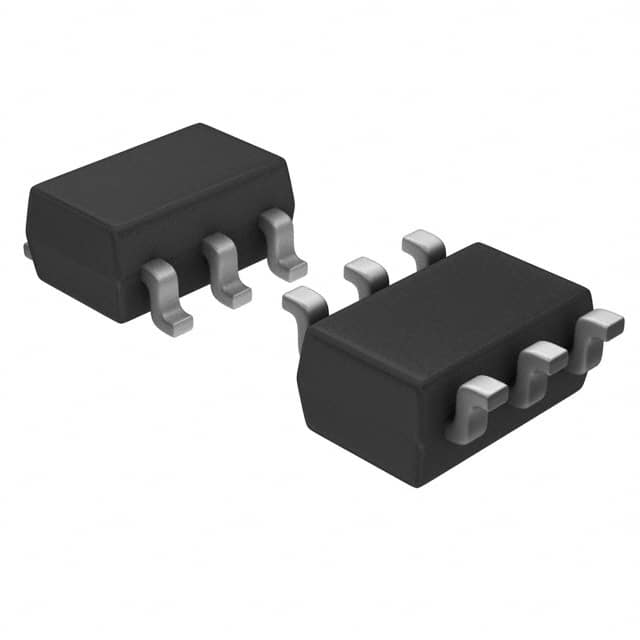Voir les spécifications pour les détails du produit.

PI4ULS3V501TAEX
Basic Information Overview
- Category: Integrated Circuit (IC)
- Use: Level Shifter
- Characteristics: Low voltage level shifting, high-speed operation
- Package: TSSOP-8
- Essence: Translates signals between different voltage levels
- Packaging/Quantity: Tape and Reel, 2500 units per reel
Specifications
- Supply Voltage Range: 1.2V to 3.6V
- Input Voltage Range: 0V to VCC
- Output Voltage Range: 0V to VCC
- Maximum Data Rate: 100 Mbps
- Operating Temperature Range: -40°C to +85°C
Detailed Pin Configuration
The PI4ULS3V501TAEX has a total of 8 pins arranged as follows: 1. VCCA: Power supply for the A-side logic (1.2V to 3.6V) 2. GND: Ground reference for the IC 3. OE: Output Enable pin, controls the output state 4. A1: Input/Output pin for the A-side logic 5. A2: Input/Output pin for the A-side logic 6. B1: Input/Output pin for the B-side logic 7. B2: Input/Output pin for the B-side logic 8. VCCB: Power supply for the B-side logic (1.2V to 3.6V)
Functional Features
- Bidirectional level shifting between two voltage domains
- Supports voltage translation from 1.2V to 3.6V
- High-speed operation with a maximum data rate of 100 Mbps
- Low power consumption
- ESD protection on all pins
Advantages and Disadvantages
Advantages: - Wide supply voltage range allows compatibility with various systems - High-speed operation enables efficient data transmission - Small package size (TSSOP-8) for space-constrained applications - ESD protection ensures robustness against electrostatic discharge
Disadvantages: - Limited to bidirectional level shifting, not suitable for unidirectional applications - Maximum data rate may not be sufficient for certain high-speed communication protocols
Working Principles
The PI4ULS3V501TAEX is a bidirectional level shifter that translates signals between two voltage domains. It operates by using a combination of MOSFETs and control logic to convert the input signal levels to the corresponding output levels. The OE pin controls the output state, allowing the user to enable or disable the translation function.
Detailed Application Field Plans
The PI4ULS3V501TAEX is commonly used in various applications where level shifting is required. Some potential application fields include: 1. Communication systems: Used to interface between different voltage domains in communication protocols such as UART, I2C, SPI, etc. 2. Consumer electronics: Enables compatibility between low-voltage microcontrollers and higher voltage peripherals like sensors, displays, and memory devices. 3. Industrial automation: Facilitates signal translation between different voltage levels in industrial control systems, PLCs, and motor drives. 4. Automotive electronics: Supports voltage translation in automotive applications, including infotainment systems, body control modules, and engine management systems.
Detailed and Complete Alternative Models
- TXB0108: 8-bit bidirectional voltage-level translator with automatic direction sensing.
- SN74LVC8T245: 8-bit dual-supply bus transceiver with configurable voltage translation.
- PCA9306: Dual bidirectional I2C-bus and SMBus voltage-level translator.
These alternative models offer similar functionality and can be considered based on specific requirements and design constraints.
Word count: 345 words
Énumérez 10 questions et réponses courantes liées à l'application de PI4ULS3V501TAEX dans les solutions techniques
Sure! Here are 10 common questions and answers related to the application of PI4ULS3V501TAEX in technical solutions:
Q: What is PI4ULS3V501TAEX? A: PI4ULS3V501TAEX is a high-speed level shifter IC designed for translating signals between different voltage domains.
Q: What voltage levels can PI4ULS3V501TAEX support? A: PI4ULS3V501TAEX supports voltage translation between 1.2V, 1.8V, 2.5V, 3.3V, and 5V logic levels.
Q: How many channels does PI4ULS3V501TAEX have? A: PI4ULS3V501TAEX has 5 bidirectional channels, allowing for simultaneous translation of multiple signals.
Q: Can PI4ULS3V501TAEX handle high-speed data transmission? A: Yes, PI4ULS3V501TAEX is designed for high-speed applications and can support data rates up to several gigabits per second.
Q: Is PI4ULS3V501TAEX compatible with different types of digital interfaces? A: Yes, PI4ULS3V501TAEX can be used with various digital interfaces such as I2C, SPI, UART, GPIO, etc.
Q: Does PI4ULS3V501TAEX require external components for operation? A: Yes, PI4ULS3V501TAEX requires external pull-up resistors and decoupling capacitors for proper functionality.
Q: Can PI4ULS3V501TAEX operate in both direction modes simultaneously? A: No, PI4ULS3V501TAEX can operate in either unidirectional or bidirectional mode, but not both simultaneously.
Q: What is the power supply voltage range for PI4ULS3V501TAEX? A: PI4ULS3V501TAEX operates with a power supply voltage range of 1.65V to 5.5V.
Q: Is PI4ULS3V501TAEX suitable for battery-powered applications? A: Yes, PI4ULS3V501TAEX has low power consumption and can be used in battery-powered devices.
Q: Are there any specific layout considerations for using PI4ULS3V501TAEX? A: Yes, it is recommended to follow the layout guidelines provided in the datasheet to ensure optimal performance and signal integrity.
Please note that these answers are general and may vary depending on the specific application and requirements.

